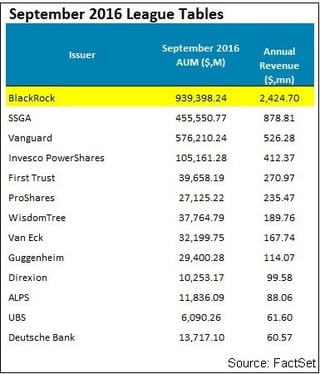With BlackRock blowing the trumpet on the latest charge in the ETF fee wars, it’s reasonable to ask the question: how much does this really matter?
To answer that question, we can look at a back-of-the-napkin calculation on the revenue generating potential of any fund. If we take today’s assets (which of course, will change over the next year), and simply multiply it by the expense ratio, we can create what I call an "annual revenue potential" for any given fund.
Now, there are of course apples to oranges problems here. Some firms have unitary fees, where all the expenses are paid by the management company. Some allow their expenses to float, leaving line items intact for different parts of the ETF ecosystem. Heck, a few ETFs even charge small 12b-1 distribution fees (only the Select Sector SPDRs, to my knowledge).
Still, my made-up metric does capture the overall revenue potential for the whole ETF ecosystem.
By that measurement, the $2.4 trillion in ETFs at the end of September, using Blackrock’s new fees, would generate roughly $6.043 billion in revenue for the industry as a whole.

There are a few interesting things to note here at the top of the league table. When calculated on a revenue basis, some smaller issues with relatively high-fee products move up (like First Trust), and lower cost providers like Schwab and Vanguard look slightly less dominant, with Schwab falling off the map entirely to 17th place by revenue.
So how big a hit will BlackRock take by slashing prices to compete on cost? It turns out the delta is roughly $74 million. Not the end of the world, but not chump change either. So BlackRock is betting on capturing some pretty significant new assets to make up for that loss in revenue.
The reason for the cut, as reported pretty much everywhere, is to compete for money expected to flood into low-cost ETFs after the full implementation of the Department of Labor fiduciary rule. That shift, which will predominately impact brokers who currently live under a much laxer “suitability” standard, means that compliance departments across the country are scrambling to rethink the products their wealth management folks recommend. A fiduciary standard means (almost literally) that the advisor has to recommend the product they themselves would pick in their clients situation. That makes justifying an underperforming active manager very very difficult, sure, but it also makes it very difficult to justify paying, say, nine basis points for an S&P 500 ETF when there’s a four basis point version available.
The result: an endless series of “bake offs” at wealth shops, either formal or informal, where individual advisors and due diligence teams alike pick the “best” products for their clients. And while it’s definitely the case that there are fantastic ETFs out there that cost a lot more than 10 basis points, cost is one of the easiest factors to focus on, especially if the investment being considered is plain vanilla.
Enter Smart Beta
And make no mistake, plain vanilla still dominates the industry. $1.7 trillion are currently in plain vanilla ETFs, generating $3.8 billion in revenue.

By comparison, the “non-vanilla” part of the market generates $2.25 billion, despite having only 28% of the overall assets. And if you filter out the truly cheap vanilla, the difference is even more profound. Remember, there are some very pricey plain vanilla funds out there. We consider most leveraged and inverse funds, for example, to be “vanilla” because their underlying indexes tend to be pretty plain vanilla. But note Proshares and Direxion easily make the top 10 list by revenue.
Looking forward, this means were really looking at a bifurcation of the ETF market. On one hand, we’re going to have a lot of assets in a small number of very low cost plain vanilla products, which, on a dollar by dollar basis, are relatively unimportant to the bottom lines of their issuers. On the other end of the barbell, we’ll continue to see a raft of relatively high-cost ETFs chasing themes, factors, fundamentals, niche markets, and using leverage which can be enormously important to the bottom line.
Welcome to the ETF future.
